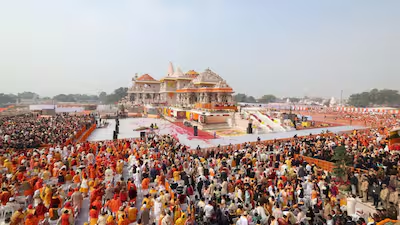
The New Ram Temple: Progress and Significance
Ayodhya’s Grand Transformation: One Year After the Ram Temple Consecration
Ayodhya, a year after the grand consecration of the Ram Temple, is experiencing rapid transformation. With the temple’s completion now set for March 30, 2025, the city is upgrading its infrastructure to meet the soaring number of pilgrims, with new roads, hotels, and flyovers under construction.
Ayodhya: A Year After Ram Temple Consecration – A City Under Transformation
In the year since the grand consecration ceremony of the Ram Temple in Ayodhya, the city has experienced a whirlwind of change. Once a quaint town with a population of about 80,000, Ayodhya is now at the forefront of India’s spiritual tourism boom. Pilgrims from all corners of the country and even abroad are making their way to the sacred site, drawn by the promise of witnessing one of India’s most awaited religious landmarks. The completion of the Ram Temple, now expected by March 30, 2025, is expected to be a turning point for Ayodhya, with its transformation into a world-class pilgrimage destination well underway.
The Ram Temple: More Than Just a Place of Worship
At the heart of Ayodhya’s transformation is the Ram Temple, a monument that is poised to change the landscape of this historic city. The grand consecration ceremony in 2024 was only the beginning of what will be a decades-long journey for the temple’s full construction. Despite some delays, the temple is set to be completed by the new deadline in March 2025, a date eagerly awaited by millions of devotees across the globe.
The design of the Ram Temple is a breathtaking blend of ancient craftsmanship and modern engineering. The temple’s central sanctum, which will house the idol of Lord Ram, is nearing completion. The structure’s towering spires and intricately carved sandstone reflect the grandeur of India’s spiritual heritage. Once fully constructed, the temple is expected to be a major pilgrimage destination, attracting millions of devotees each year.
Meeting the Challenge of Growing Footfall
The demand for access to the Ram Temple has skyrocketed in the wake of its consecration. Pilgrim numbers have surged, with daily visitors often outnumbering the city’s total population by threefold. The authorities in Ayodhya are working hard to meet the challenges posed by the increasing footfall, addressing the needs for transportation, accommodation, and overall city infrastructure.
Infrastructure Development in Full Swing
To accommodate the rising number of pilgrims, Ayodhya is undergoing a significant infrastructure overhaul. Several key projects are currently underway to ensure that the city can handle the increasing demand:
- Roads and Flyovers: Major highways leading to Ayodhya are being expanded, and new flyovers are under construction to ease traffic congestion. These developments are expected to improve access to the temple and surrounding areas.
- Hotels and Accommodations: The city’s hospitality sector is booming. New hotels, guesthouses, and dharamshalas are being built across Ayodhya to accommodate the influx of visitors. Whether it’s a budget stay or a luxury experience, accommodations are being expanded to cater to all kinds of pilgrims.
- Public Transport Upgrades: Ayodhya is also investing in transportation infrastructure, with new buses, electric rickshaws, and shuttle services being introduced to move pilgrims efficiently from one location to another.Economic Impact of the Transformation
Ayodhya’s rise as a pilgrimage hub is also generating substantial economic growth. Local businesses, including shops selling religious paraphernalia and eateries catering to hungry pilgrims, are flourishing. The rise in tourism has also created new employment opportunities, particularly in the hospitality and construction sectors.
Local authorities anticipate that Ayodhya’s tourism revenue will see a dramatic increase in the coming years, with the city becoming one of India’s top pilgrimage destinations.
Balancing Tradition with Modernization
As Ayodhya embraces rapid modernization, it must strike a delicate balance between preserving its rich cultural heritage and meeting the demands of modernity. There is a conscious effort to retain the city’s historical charm while ensuring that new developments don’t overpower its spiritual essence.
This approach is most evident in the restoration projects along the Sarayu Riverfront, where the government is working to create a picturesque setting for pilgrims and visitors. Planned parks and heritage sites will offer visitors a chance to relax while soaking in the city’s spiritual atmosphere.
However, as Ayodhya modernizes, it also faces significant challenges:
- Crowd Management: Managing millions of visitors each year is no small feat. Authorities must find innovative solutions to maintain safety and convenience for pilgrims.
- Environmental Sustainability: With the increasing number of visitors, there’s a growing need for sustainable tourism practices to protect Ayodhya’s environment and cultural sites.
The Road Ahead for Ayodhya
As Ayodhya approaches the completion of the Ram Temple, the city’s future is full of promise. The ongoing infrastructure development, along with the rise of tourism, is expected to bring about long-term economic benefits. However, the city must also remain mindful of the need for sustainable growth.
Ayodhya stands at the cusp of a new era, one where spirituality and modernity can coexist in harmony. The completion of the Ram Temple in March 2025 will mark the culmination of decades of faith, and Ayodhya will undoubtedly become a must-visit destination for pilgrims around the world.